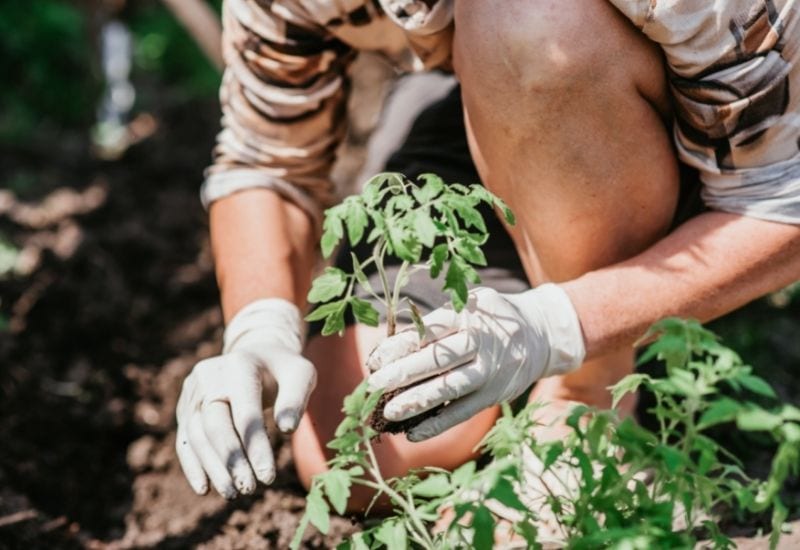
Homegrown tomatoes are some of the most popular garden plants on the planet. There is nothing quite like a ripe juicy tomato straight from the vine in the summer heat.
Tomatoes are super vigorous plants that can grow over 6 feet tall and carry dozens of fruit, but they can also be prone to lots of problems and their success mostly depends on how you plant them.
Whether you’re growing heirlooms, cherry tomatoes, hybrids, or a combination of varieties- tomatoes need to be planted at the proper spacing, depth, and time.
After 6 years of producing organic tomatoes on a commercial scale, I’ve discovered these 10 crucial tips for growing tomatoes with higher yields, better quality, and less work.
10 Tomato Planting Hacks for a High Yield Harvest
A healthy start to life is important for all living things, but especially vegetables. You need to start with the highest quality tomato seedlings that aren’t leggy or rootbound.
They should be planted after the risk of frost has passed into loamy well-drained garden soil. You can use row cover and mulches to keep young plants warm.
Tomatoes need plenty of space (12-24”) between each plant. It is also best to plant seedlings extra deep to develop a strong root zone.
Once planted, tomatoes will thrive from a generous helping of diluted kelp or fish fertilizer to water them in. All of these tips and more will help you plant the best tomatoes you’ve ever grown.
In the world of organic gardening, there is no need to choose quality over quantity. We will teach you how to grow gorgeous flavorful tomatoes that yield in abundance! Let’s dig in!
1: Start with Healthy Tomato Seedlings
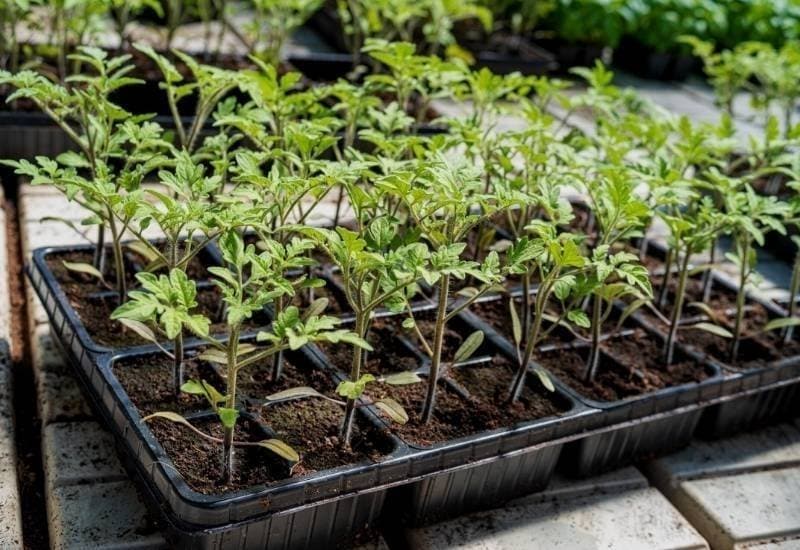
When planting tomatoes, it’s important to start with the highest quality seedlings possible.
If the plant starts out its life stressed, diseased, rootbound, or leggy, it will have a harder time taking off and may yield poorly as a result.
Sourcing high quality tomato seedlings depends on whether you are growing them yourself or buying from a nursery. Here are the most important considerations for each situation:
Tips for Growing Your Own Tomato Starts
If you are growing your own tomato seedlings, you will need a small greenhouse or south-facing window with supplemental LED grow lights.
Growing tomato starts is fairly simple, but any mistakes early in the growing stages could make or break your tomato planting.
Seed Starting Indoors
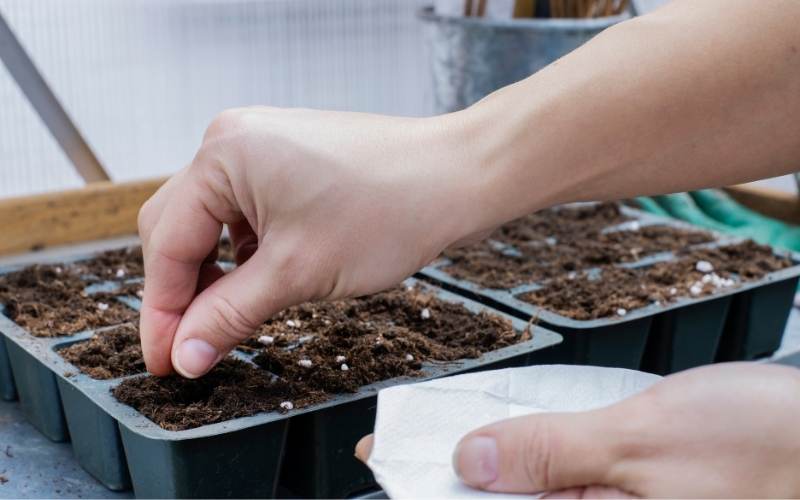
Tomato seeds should be sown at ¼” deep in a well-drained seedling mix in 6-packs or cell trays. Sow 1 seed per cell.
Lightly cover with mix, making sure not to bury seeds too deep. Use a heating pad beneath your trays for more even germination and keep the potting soil temperature around 75° to 85°F. They typically germinate within 5-7 days.
Provide Plenty of Light
“Leggy” plants are seedlings that have grown very long and tall without developing very robust stems.
This happens when tomato starts are grown in settings without enough light. They start reaching upward in search of more sunshine and end up weakening the central stem.
If you start your own seeds, this is easily avoidable by providing supplemental lighting (if starting seeds near a window indoors) or using a small greenhouse.
Don’t Crowd Seedlings
Tomato seeds tend to have a great germination rate as long as they aren’t old seeds. When tomatoes germinate, it is super important to thin them to a single plant per cell.
Crowded seedlings will get leggy more quickly and compete with each other for nutrients. It’s better to have one robust baby tomato than several weak ones. Always thin seedlings!
Potting Up Seedlings Before Transplanting To Outdoors
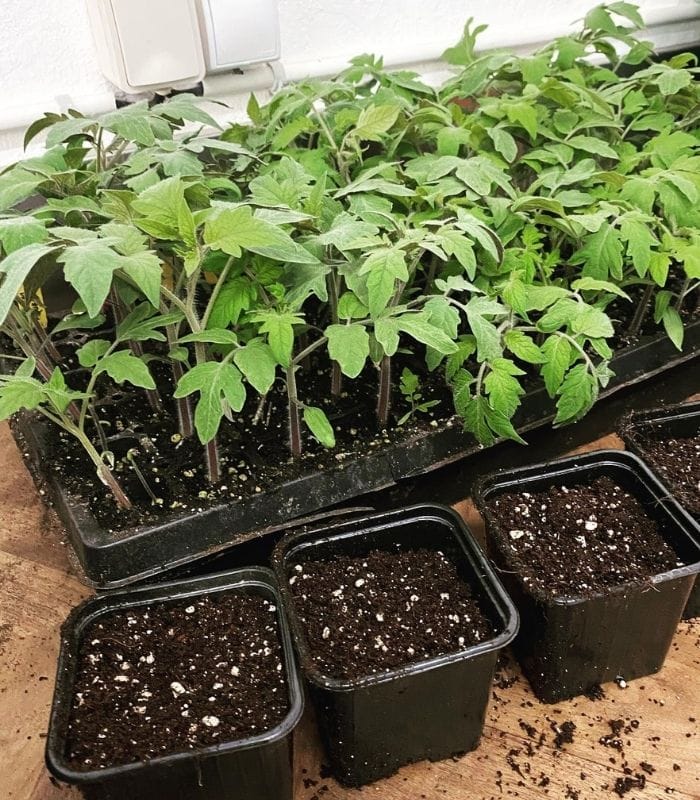
Up-potting means graduating a baby tomato to a larger pot before planting out in the garden.
This longer time in the nursery (or your house) allows the seedling to get larger and more robust before it goes outside. Up-potting one or even two times is very common in tomato production.
Tomatoes are best started in cell trays or 6-packs. Once they can be pulled out with roots intact (typically after 2-3 weeks), you can up-pot into a 4” pot up.
Plant them deep with only the first true leaves above the surface. Up-potting ensures that your seedlings don’t outgrow their pot or get root bound, so they’ll be ready to take off once you get them out into the garden.
Harden Off Before Planting
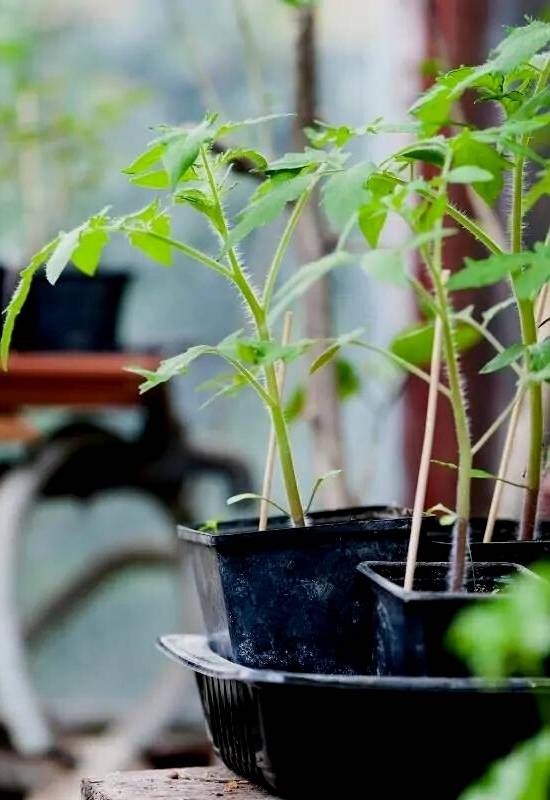
Baby tomatoes need about 1 week to acclimate to outdoor temperature fluctuations. This process is called “hardening off”.
It’s as simple as placing your tomato seedlings outside in a sheltered location while still in their pots and letting them adjust to night time temperatures for 5-7 days before planting in the garden.
Do not begin hardening off until after the risk of frost has passed and night time temperatures are reliably above 50°.
You can utilize row cover or bring them back inside at night for the first few nights to help ease the transition.
Tips for Buying Tomato Starts
Buying tomato starts is the best option for beginners because it doesn’t require the investment in seed starting equipment nor the learning curve of trying to grow your own starts.
But not all tomato seedlings are created equal and you want to be sure you buy the best of the best!
Buy from Reputable Farm or Nursery
The best places to buy tomato starts are plant nurseries or local organic vegetable farms that have plant sales.
These sources will always beat big box stores because they have more specialized vegetable knowledge and the seedlings have not been transported across the country.
Check the Leaves and Stem
When purchasing your starts, seedlings that are yellowing, brown, spotted with blight, or wilted.
Also avoid leggy seedlings that have grown too lanky while being in a small pot or low-light setting for too long.
If you must buy leggy tomato starts for whatever reason, plant them as soon and as deep as possible.
Avoid Rootbound Tomatoes
Always check the roots before buying tomatoes! Clasp the tomato at the base of the plant and slowly lift it out of the pot to inspect the roots.
If the roots are winding around and around the plant in the shape of the pot, this means it is rootbound and has been growing in a small pot for too long.
Rootbound tomatoes can still be planted, but they take more time to get going. It is best to choose seedlings that have the perfect amount of roots without being crowded or looping around in circles within the pot.
2: Plant at the Right Time
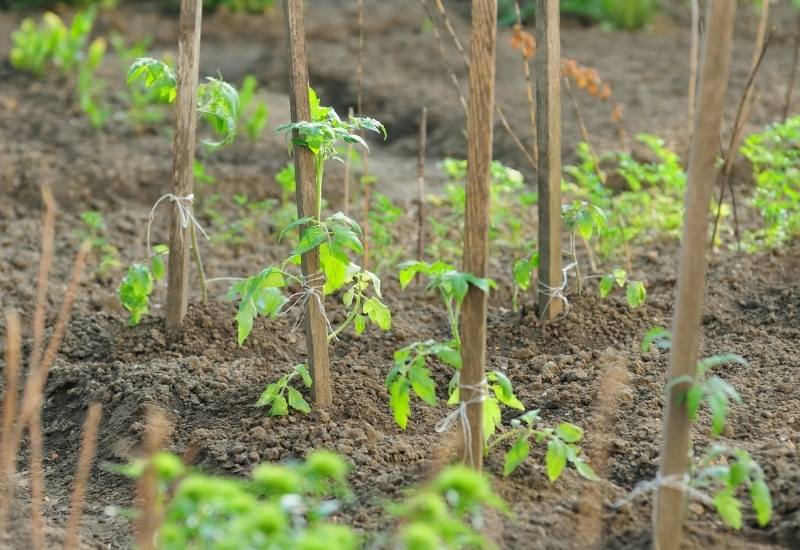
Tomatoes are warm-weather plants with little to no frost tolerance. Many people mistakenly believe that planting them earlier will bring earlier tomatoes, but this is not necessarily true.
If you plant too early and your tomatoes may die from an unexpected late frost, or they will be stunted by cold night temperatures below 45°F. This will harm early yields and potentially cut back on overall production.
However, if you plant too late, tomatoes may not have sufficient time to establish their roots, stems, and leaves (vegetative growth) before they enter reproductive growth (flowers, fruits, and seeds).
Of course you want to maximize your tomato harvests before fall frosts arrive, so use these tips to make sure you are planting at the right time:
Last Frost Date
Check the average last frost date for your region using the Old Farmer’s Almanac. Count backwards 5-7 weeks to figure out when the best time to sow your seeds is in order to have them ready to transplant at the time of the last frost.
If you are buying starts, don’t purchase them too early or you may end up with leggy tomato seedlings waiting inside by the window to be planted.
Check Your Soil Temperature
You can use a simple soil thermometer to check the soil temperature of your garden before planting.
Tomatoes prefer a soil temperature of 65 to 70° F, however they will tolerate down to 60° if they are protected from cool night temperatures.
In general, raised garden beds often warm up more quickly than in-ground garden beds because the soil holds more thermal mass inside the raised structure.
Want to Get Early Tomatoes?
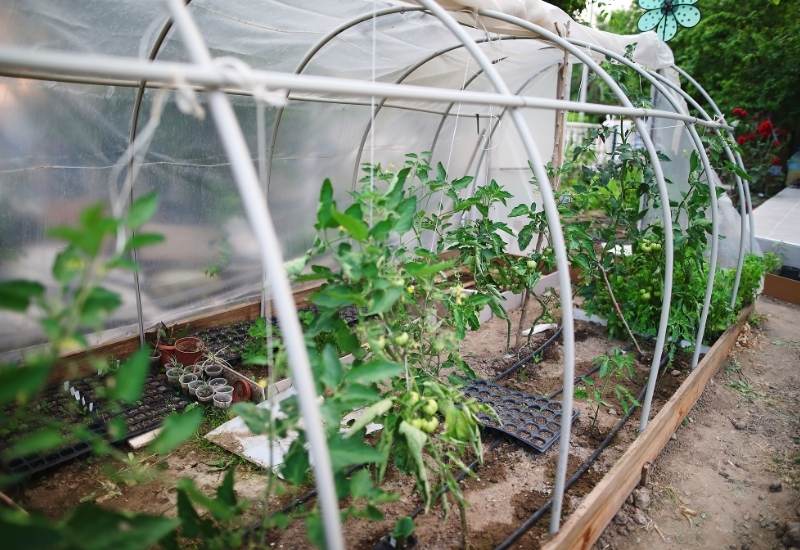
Use row cover for extra warmth! Row cover is a pro gardener and farmer secret that helps you get the earliest crops while also protecting them from pests.
This white agricultural fabric allows sunlight and water through while simultaneously creating a little dome of warmth around your tomatoes.
Row cover is best used with hoops over the young tomato plants and sandbags to hold the sides down.
3: Prepare Your Soil For Planting Tomatoes
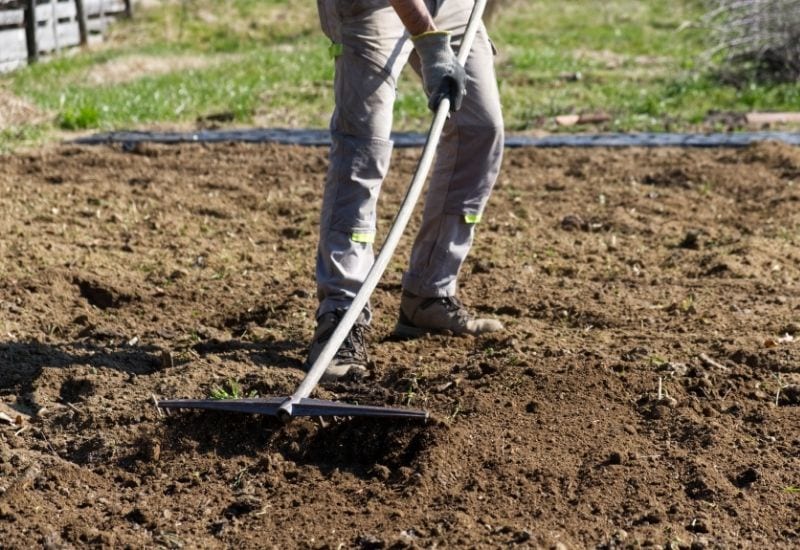
Tomatoes thrive in loamy soil that is rich in organic matter and well-drained. The ideal pH is between 6.0 and 6.8.
Don’t Plant Tomatoes in Compacted Soil
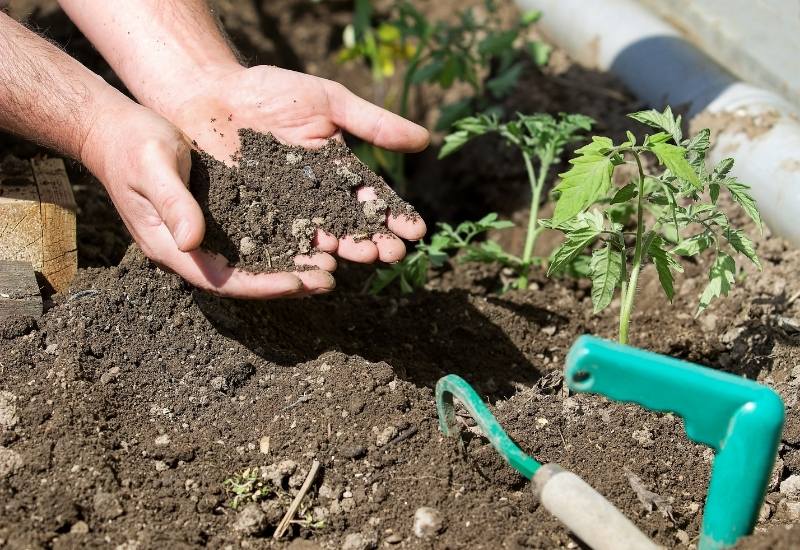
To prepare tomato beds in the garden, begin by loosening the soil with a digging fork or broadfork.
You don’t want any compaction that will prevent your plants from rooting deep into the soil. Compaction can look like cracking, crusting clay or any type of soil that won’t allow you to easily push your finger 6” or deeper into the surface.
The best remedies for compaction are aerating the soil, no-till gardening techniques, adding compost, and mulching to slowly build organic matter.
Loosen Soil and Add Compost
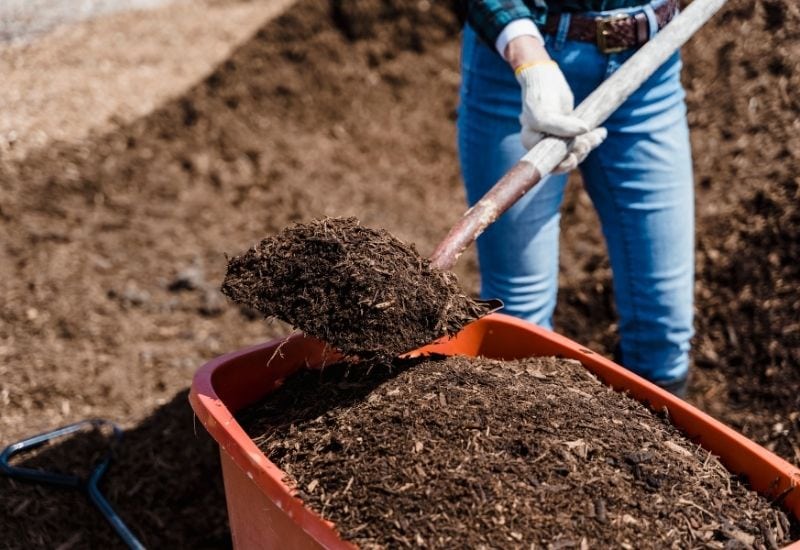
Amend tomato beds with 2-4” thick of high quality organic compost. Compost will aerate the root zone, add beneficial microorganisms, and improve the water holding capacity of the soil so it doesn’t dry out too quickly.
At the same time, compost should prevent water-logging and compaction that causes root rot in tomatoes.
4: Choose a Sunny, Spacious Location
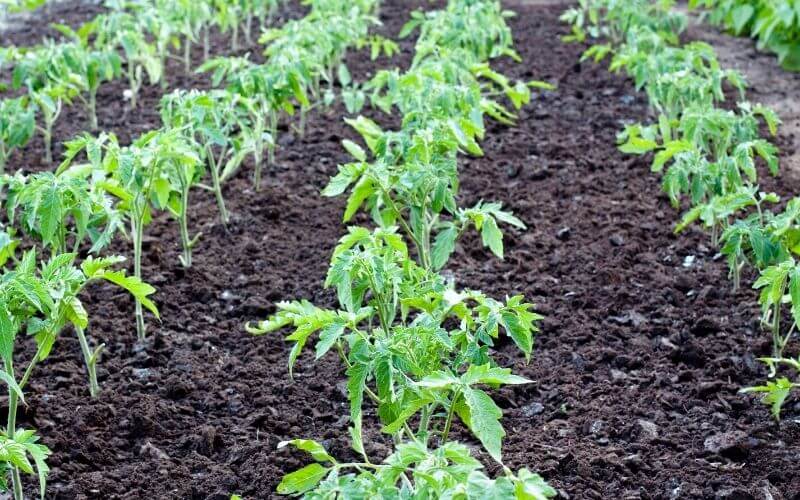
Tomatoes are hot-weather annuals that require full direct sun for at least 6 to 8 hours per day.
Avoid planting tomatoes near trees or large structures that might shade them at any point during the season.
This area of the garden should be protected from wildlife like rabbits, deer, and other pests.
Tomatoes also require plenty of space. They are prolific plants and should ideally have their own garden bed so that they can be planted with the correct spacing and trellising.
5: Plant Tomatoes at the Proper Spacing
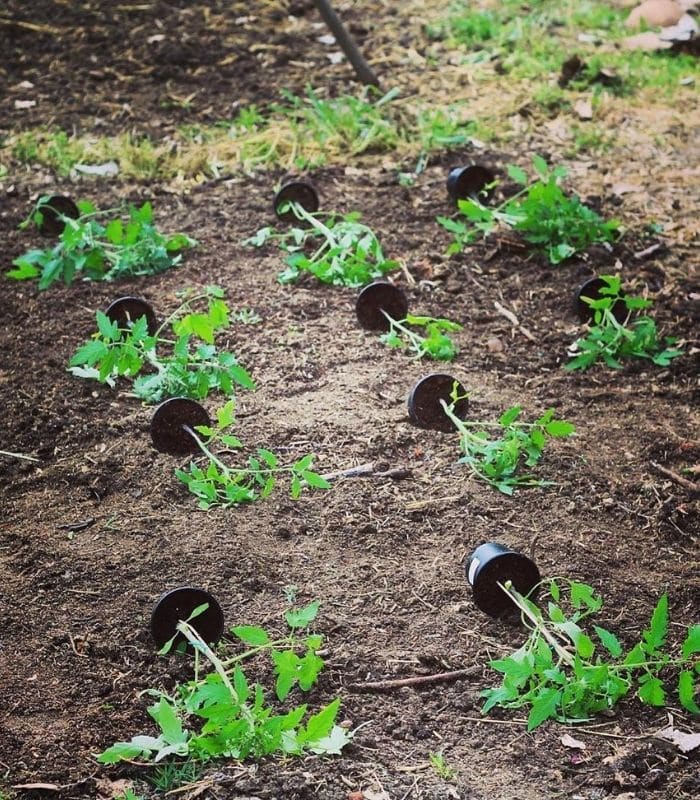
Spacing is very important for tomatoes. If they are too crowded, plants can get stressed and have poor yields.
They will also compete with each other for nutrients and water, resulting in overall less energy put into growing fruit.
Spacing for Determinate Tomatoes
Determinate or “bush” tomatoes are the kind that don’t vine or sprawl. These tomatoes are commonly grown with tomato cages or stakes as their trellis.
Determinate tomatoes should be spaced 12-24” apart in rows 2-4’ apart so they have plenty of room.
Spacing for Indeterminate Tomatoes
Indeterminate or “vining” tomatoes like to climb and branch. These varieties require 18-36” between plants and 2-4’ feet between rows.
However, spacing can be adjusted depending on the type of trellis you plan to use. You can plant tomatoes closer together when using a trellis that allows lots of upward vining.
It is vital to map out your tomato trellis system and spacing ahead of time so that you can plant accordingly.
6: Plan Your Trellis System
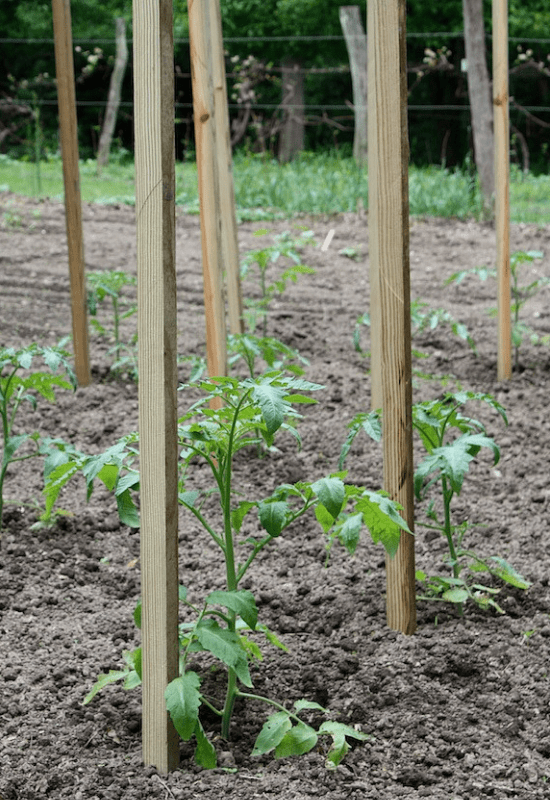
Before planting your tomatoes, it’s best to know how you are going to support them once they are heavy with fruit.
Tomato cages and stakes are great options for determinants. Tomato ladders/towers, A-frame vine support trellises, or even a cattle panel archway are excellent options for indeterminate tomatoes to vine up.
It is best to install your tomato trellis right after planting or while the plants are still small. This will help you “train” them to grow up the trellis and avoid vining or falling on the ground.
Trust me, you don’t want tomato fruits hanging out on the soil surface. Dangling tomatoes on a trellis are always cleaner, happier, and easier to harvest.
7: Plant Tomatoes Extra Deep
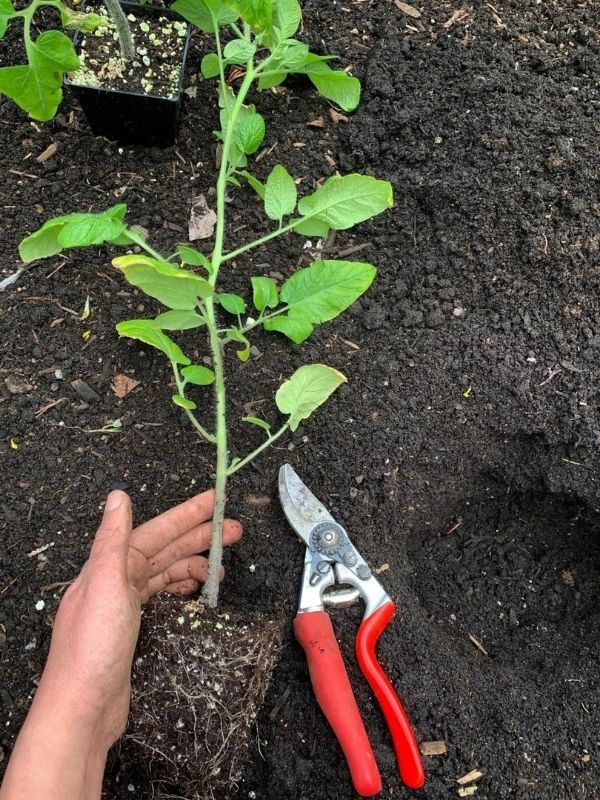
Tomatoes are unique because they can root all along their stems. This is why most professional growers plant tomatoes extra deep, often removing lower leaves and burying the stem 4-6” under the soil surface.
This creates an extra robust root system for the plant to begin with. Deeper roots mean more access to water and fertility, as well as less chances of toppling over once they are loaded with heavy fruits.
Just be sure you leave at least 2-4 sets of leaves above the surface to promote early growth.
8: Provide Plenty of Water
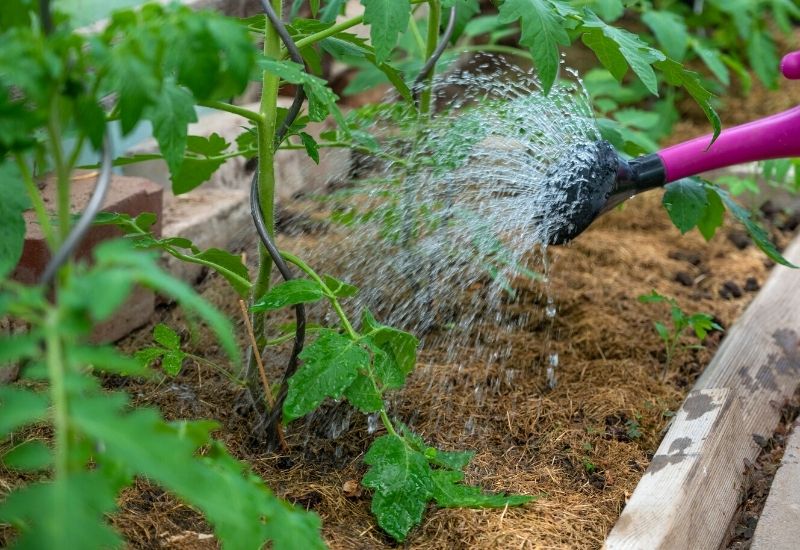
Tomatoes are thirsty plants and it is especially important that they have water in the early stages of growth.
At the time of planting, water your tomato seedlings thoroughly so they can establish their roots.
Newly planted tomatoes should have consistent moisture, never drying out but also never getting soggy.
How to Check Soil Moisture
Stick your finger in the soil to check moisture levels every 2-3 days depending on the temperatures. The soil should be moist enough to stick to your finger when you pull it out.
If your finger comes out of the soil clean, it is probably too dry and time to water. Using an organic mulch like dried leaves or straw helps conserve water and prevent new plants from drying out.
How to Irrigate Tomatoes
It is best to water tomato plants with a garden hose, watering can, drip irrigation, or soaker hoses. Do not use overhead irrigation (sprinklers) because it will promote blights or other diseases on the leaf surfaces.
9: Burry fish heads When Planting Tomatoes
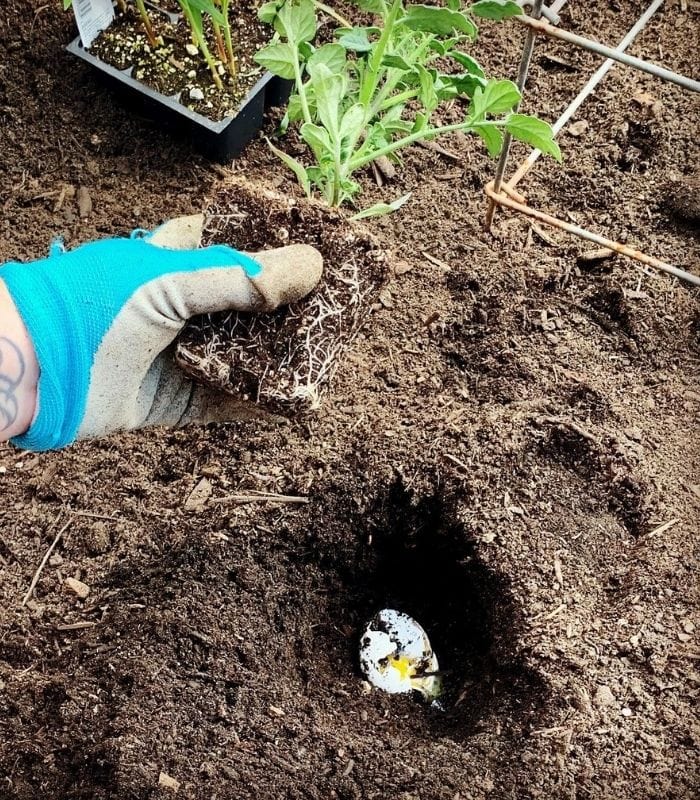
Fertility is very important for tomatoes because they put on a lot of biomass in a short amount of time. And your tomatoes will grow better with a fish head under the plant.
And burying a fish (all leftover fish parts actually) underneath your tomato plant paired with aspirin and a few other amendments will grow the most stupendous tomatoes ever.
At the time of planting, tomatoes should be “watered in” with a diluted fish and kelp mixture to give them a jump start (remember to dilute with the instructions on the bottle).
You can also plant a tablespoon of organic all-purpose granular fertilizer in the planting hole for a slow-release food source.
The most important thing is to avoid excess nitrogen fertilizer in the early stages because it will promote lots of leaves and no fruit.
10: Practice Crop Rotation
Tomatoes are subject to a variety of plant pests and diseases, including:
Thankfully, most of these issues can be avoided by following the steps above to grow a healthy, robust tomato plant from the very beginning.
Just like humans, a healthy strong tomato plant is naturally going to be less susceptible to illness.
But, for an extra layer of support, it is best to rotate tomatoes and their relatives (peppers, potatoes, eggplants) around the garden so they don’t grow in the same place every year.
This helps diversify the beneficial soil microbes in your garden beds and prevent pathogens from taking hold. It also confuses insect pests and helps keep the natural ecology functioning in your favor.
FAQs
What is the best month to plant tomatoes?
Tomatoes are usually planted outdoors from early April to late May, depending on the growing zone.
It is best to sow tomatoes in early spring about 6-8 weeks before the last frost. This is often February to mid-March depending on the region.
How deep should tomatoes be planted?
Tomatoes can be planted quite deep because they will root all along the stem. Dig a hole about 8-12” deep and remove lower leaves, leaving 2-4 sets on the top of the seedling.
Plant the root ball and stem into the hole and backfill lightly, being sure not to press or compact the soil in.
How far apart should you plant tomatoes?
Determinate tomatoes can be spaced 12-24” apart, while indeterminate tomatoes should be 18-36”. Space rows 2-4’ apart to give tomatoes plenty of room.

Written By
Amber Noyes
Amber Noyes was born and raised in a suburban California town, San Mateo. She holds a master’s degree in horticulture from the University of California as well as a BS in Biology from the University of San Francisco. With experience working on an organic farm, water conservation research, farmers’ markets, and plant nursery, she understands what makes plants thrive and how we can better understand the connection between microclimate and plant health. When she’s not on the land, Amber loves informing people of new ideas/things related to gardening, especially organic gardening, houseplants, and growing plants in a small space.
